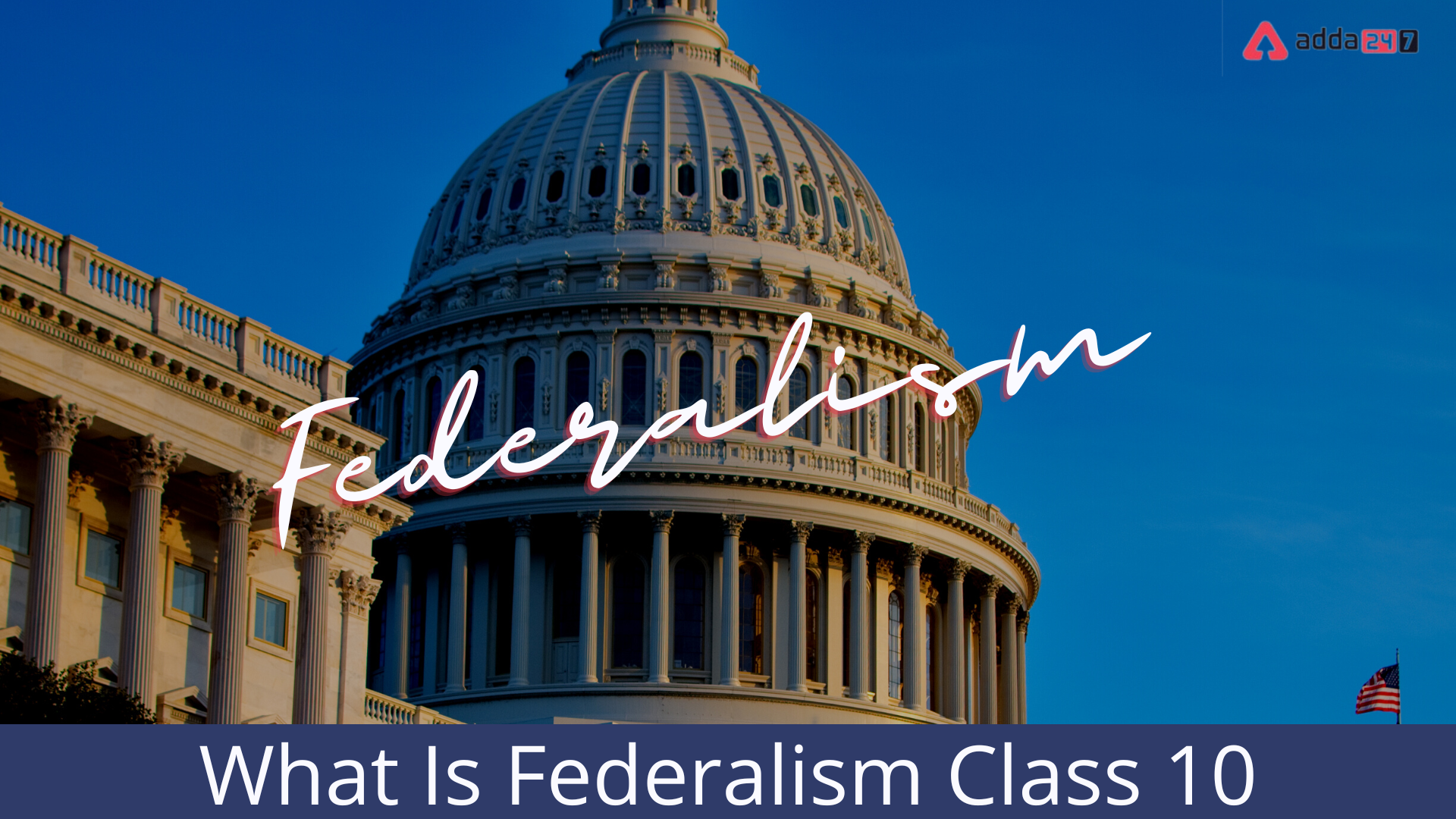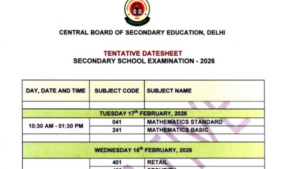What Is Federalism Definition for Class 10?
Federalism is the compound mode of two governments. That is, in one system there will be a mixture of two governments – the state government with the central government. In India, we can describe federalism as a distribution of authority around local, national, and state governments. This is similar to the Canadian model of political organization.
Federalism is at its core a system where the dual machinery of government functions. Generally, under federalism, there are two levels of government. One is a central authority that looks after the major affairs of the country. The other is more of a local government that looks after the day-to-day functioning and activities of their particular region.
For example, our Indian Constitution says that India too is a federal country. As you know we have two levels of parliament, at the center the Union government and at State level, we have the individual State governments.
What Is Federalism in the Constitution?- Features
The best way to comprehensively understand the federal system is to learn about its features. These characteristics combined to reflect the true essence of federalism. Let us study them.
- The essential feature, which is the definition of federalism, is that there are two levels of governance in the country. There can even be more. But the entire power is not concentrated with one government.
- All levels of governance will govern the same citizens, but their jurisdiction will be different. This means that each level of government will have a specific power to form laws, legislate and execute these laws. Both of the governments will have clearly marked jurisdiction. It will not be that one of the governments is just a figurehead government.
- Another important feature is that the constitution must guarantee this federal system of government. Which means the powers and duties of both or all governments must be listed down in the constitution of that country hence guaranteeing a federal system of governance.
- As stated above the federalism of a country must be prescribed by the constitution. But it is also important that just one level of government cannot make unilateral changes or amendments to the important and essential provisions of the constitution. Such changes must be approved by all the levels of the government to be carried through.
- Now there are two levels of government with separate jurisdictions and separate duties. Yet there is still a possibility that a conflict may arise between the two. Well in a federal state, it will fall upon the courts or rather the judiciary to resolve this conflict. The courts must have the power to interfere in such a situation and reach a resolution.
- While there is power sharing between the two levels of government, there should also be a system in place for revenue sharing. Both levels of government should have their own autonomous revenue streams. Because if one such government depends on the other for funds to carry out its functions, it really is not autonomous in its true nature.
What is federalism How does it work in India?
India is a federal country. But not once in the constitution is the word “federation” ever mentioned. Instead what is said is that India is a “Union of States’.Actually many historians believe that India is a quasi-federal country. It means it is a federal state with some features of a unitary government. Let us see the reasons.
The constitution of India has essentially prescribed a federal state of government. As you already know we have several levels of government, The Government at the center, which is the Lok Sabha and the Rajya Sabha. Then the various state governments, the Vidhan Sabhas, and the Vidhan Parishad. And finally, we have the Municipal Corporations and the Panchayats, which are forms of local governance.
Our constitution makes a clear demarcation about legislative powers and jurisdictions. It is done through the three lists.
- Union List: This includes subjects that carry national importance, like defense, finance, railways, banking etc. So such subjects only the Central Government is allowed to make laws.
- State List: Includes all matters important to the functioning of a particular trade like transport, Trade, Commerce, agriculture etc. The state government is the deciding authority for framing laws on these subjects
- Concurrent List: This list includes topics on which both the Union and the state government can make laws. These are related to education, forests, trade unions etc. One point to be noted is if the two governments are in conflict with these laws, the decision of the Union Government will prevail, It is the final authority,
What Is Federalism in Hindi?
संघवाद दो सरकारों की मिश्रित प्रणाली है। यानी एक व्यवस्था में दो सरकारों का मिश्रण होगा- केंद्र सरकार के साथ राज्य सरकार। भारत में, हम संघवाद का वर्णन स्थानीय, राष्ट्रीय और राज्य सरकारों के इर्द-गिर्द सत्ता के वितरण के रूप में कर सकते हैं। यह राजनीतिक संगठन के कनाडाई मॉडल के समान है।
संघवाद अपने मूल में एक ऐसी व्यवस्था है जहाँ सरकार की दोहरी मशीनरी कार्य करती है। आम तौर पर, संघवाद के तहत, सरकार के दो स्तर होते हैं। एक केंद्रीय प्राधिकरण है जो देश के प्रमुख मामलों को देखता है। दूसरा एक स्थानीय सरकार है जो अपने विशेष क्षेत्र के दिन-प्रतिदिन के कामकाज और गतिविधियों की देखभाल करती है।
उदाहरण के लिए, हमारा भारतीय संविधान कहता है कि भारत भी एक संघीय देश है। जैसा कि आप जानते हैं कि हमारे पास संसद के दो स्तर हैं, केंद्र में केंद्र सरकार और राज्य स्तर पर, हमारे पास अलग-अलग राज्य सरकारें हैं।
संविधान में संघवाद क्या है?- विशेषताएं
संघीय प्रणाली को व्यापक रूप से समझने का सबसे अच्छा तरीका इसकी विशेषताओं के बारे में जानना है। ये विशेषताएं संघवाद के वास्तविक सार को प्रतिबिंबित करने के लिए संयुक्त हैं। आइए उनका अध्ययन करें।
अनिवार्य विशेषता, जो संघवाद की परिभाषा है, वह यह है कि देश में शासन के दो स्तर हैं। और भी हो सकता है। लेकिन पूरी शक्ति एक सरकार के पास केंद्रित नहीं है।
शासन के सभी स्तर एक ही नागरिक पर शासन करेंगे, लेकिन उनका अधिकार क्षेत्र अलग होगा। इसका मतलब है कि सरकार के प्रत्येक स्तर के पास कानून बनाने, कानून बनाने और इन कानूनों को लागू करने की विशिष्ट शक्ति होगी। दोनों सरकारों के पास स्पष्ट रूप से चिह्नित क्षेत्राधिकार होगा। ऐसा नहीं होगा कि सरकारों में से एक सिर्फ एक ढोंगी सरकार है।
एक और महत्वपूर्ण विशेषता यह है कि संविधान को सरकार की इस संघीय प्रणाली की गारंटी देनी चाहिए। जिसका अर्थ है कि दोनों या सभी सरकारों की शक्तियों और कर्तव्यों को उस देश के संविधान में सूचीबद्ध किया जाना चाहिए, इसलिए शासन की एक संघीय प्रणाली की गारंटी है।
जैसा कि ऊपर कहा गया है कि किसी देश का संघवाद संविधान द्वारा निर्धारित किया जाना चाहिए। लेकिन यह भी महत्वपूर्ण है कि सिर्फ एक स्तर की सरकार संविधान के महत्वपूर्ण और आवश्यक प्रावधानों में एकतरफा बदलाव या संशोधन नहीं कर सकती है। इस तरह के परिवर्तनों को सरकार के सभी स्तरों द्वारा अनुमोदित किया जाना चाहिए।
अब सरकार के दो स्तर अलग-अलग अधिकार क्षेत्र और अलग-अलग कर्तव्यों के साथ हैं। फिर भी दोनों के बीच अनबन की आशंका बनी हुई है। खैर एक संघीय राज्य में, इस संघर्ष को हल करने के लिए अदालतों या न्यायपालिका पर निर्भर करेगा। अदालतों को ऐसी स्थिति में हस्तक्षेप करने और समाधान तक पहुंचने की शक्ति होनी चाहिए।
जबकि सरकार के दो स्तरों के बीच सत्ता का बंटवारा होता है, राजस्व बंटवारे के लिए भी एक प्रणाली होनी चाहिए। सरकार के दोनों स्तरों की अपनी स्वायत्त राजस्व धाराएँ होनी चाहिए। क्योंकि यदि एक ऐसी सरकार अपने कार्यों को करने के लिए धन के लिए दूसरे पर निर्भर करती है, तो यह वास्तव में अपने वास्तविक स्वरूप में स्वायत्त नहीं है।
संघवाद क्या है यह भारत में कैसे काम करता है?
भारत एक संघीय देश है। लेकिन संविधान में एक बार भी “फेडरेशन” शब्द का उल्लेख नहीं किया गया है। इसके बजाय जो कहा जाता है वह यह है कि भारत एक “राज्यों का संघ” है। वास्तव में कई इतिहासकार मानते हैं कि भारत एक अर्ध-संघीय देश है। इसका मतलब है कि यह एक संघीय राज्य है जिसमें एकात्मक सरकार की कुछ विशेषताएं हैं। आइए कारणों को देखें।
भारत के संविधान ने अनिवार्य रूप से सरकार के एक संघीय राज्य को निर्धारित किया है। जैसा कि आप पहले से ही जानते हैं कि हमारे पास सरकार के कई स्तर हैं, केंद्र में सरकार, जो लोकसभा और राज्यसभा है। फिर विभिन्न राज्य सरकारें, विधानसभाएं और विधान परिषद। और अंत में, हमारे पास नगर निगम और पंचायतें हैं, जो स्थानीय शासन के रूप हैं।
हमारा संविधान विधायी शक्तियों और अधिकार क्षेत्र के बारे में स्पष्ट सीमांकन करता है। यह तीन सूचियों के माध्यम से किया जाता है।
संघ सूची: इसमें राष्ट्रीय महत्व के विषय शामिल हैं, जैसे रक्षा, वित्त, रेलवे, बैंकिंग आदि। इसलिए ऐसे विषयों को केवल केंद्र सरकार को कानून बनाने की अनुमति है।
राज्य सूची: परिवहन, व्यापार, वाणिज्य, कृषि आदि जैसे किसी विशेष व्यापार के कामकाज के लिए महत्वपूर्ण सभी मामलों को शामिल करता है। राज्य सरकार इन विषयों पर कानून बनाने के लिए निर्णायक प्राधिकरण है।
समवर्ती सूची: इस सूची में ऐसे विषय शामिल हैं जिन पर केंद्र और राज्य सरकार दोनों कानून बना सकते हैं। ये शिक्षा, वन, ट्रेड यूनियन आदि से संबंधित हैं। ध्यान देने योग्य बात यह है कि यदि दोनों सरकारें इन कानूनों के विरोध में हैं, तो केंद्र सरकार का निर्णय मान्य होगा, यह अंतिम प्राधिकरण है,
Found this article helpful?
Reach us by means of visit or call our senior instructor at +91-9625869989 to figure out additional information about the various choices and streams that are open.
We would really see the value in it on the off chance that you could grant a portion of your insight. By utilizing our application, tests, and YouTube class help, you can unwind any vulnerability assuming that you’re centered around getting the best grades Adda247
What Is Federalism?- FAQs
Question 1 What do you mean by Federalism?
Ans. Federalism is a mixed or compound mode of government that combines a general government (the central or “federal” government) with regional governments (provincial, state, cantonal, territorial, or other subunit governments) in a single political system, dividing the powers between the two.
Question 2 What are the main features of Federalism Class 10?
Ans. What are the prominent features of Federalism?
- The power is distributed among the executive, judiciary and legislative.
- The national government shares powers with the provincial governments.
- Government power is divided between different levels of government.
- Elected officials exercise supreme power in the government.
Question 3 What is another word for federalism?
Ans. In this page you can discover 6 synonyms, antonyms, idiomatic expressions, and related words for federalism, like: constitutionalism, neoliberalism, globalism, liberalism, regionalism and decentralization.









 CBSE Date Sheet 2026 for Class 10 & ...
CBSE Date Sheet 2026 for Class 10 & ...
 CBSE Class 10 Date Sheet 2026, Check 10t...
CBSE Class 10 Date Sheet 2026, Check 10t...
 CUET History Syllabus 2026 (Updated), Do...
CUET History Syllabus 2026 (Updated), Do...






